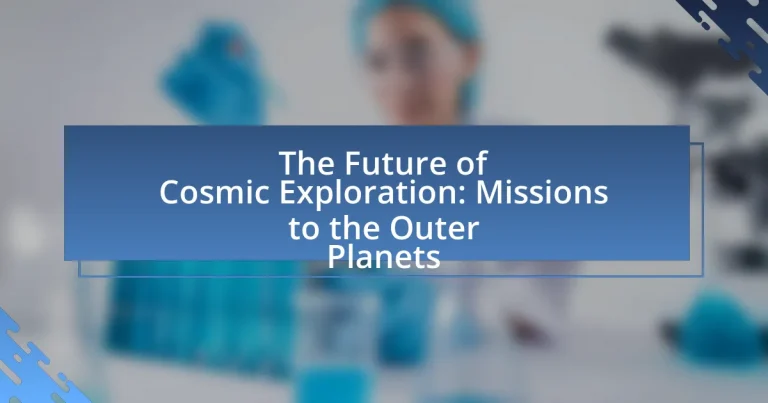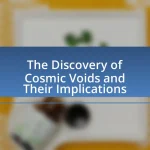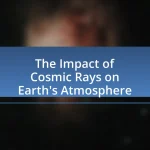The article focuses on the future of cosmic exploration, particularly missions targeting the outer planets: Jupiter, Saturn, Uranus, and Neptune. It highlights significant upcoming missions, such as NASA’s Artemis program and the European Space Agency’s JUICE mission, which aim to enhance our understanding of these celestial bodies and their potential for habitability. The article also discusses the importance of cosmic exploration for humanity, historical milestones, current trends, technological advancements, and the role of international collaborations. Additionally, it addresses the challenges faced in exploring the outer planets and outlines the objectives of future missions, emphasizing the need for continued investment and innovation in space exploration.

What is the Future of Cosmic Exploration?
The future of cosmic exploration is focused on missions to the outer planets, with significant advancements expected in the coming decades. NASA’s Artemis program aims to establish a sustainable human presence on the Moon, which will serve as a stepping stone for deeper space exploration, including Mars and beyond. The European Space Agency’s Jupiter Icy Moons Explorer (JUICE) mission, set to launch in 2023, will investigate Jupiter’s moons, providing insights into their potential habitability. Additionally, the planned NASA mission to Titan, Saturn’s largest moon, aims to explore its unique environment and organic chemistry. These missions are supported by advancements in technology, such as improved propulsion systems and autonomous spacecraft, which enhance our capability to explore distant celestial bodies.
Why is cosmic exploration important for humanity?
Cosmic exploration is important for humanity because it enhances our understanding of the universe, which can lead to advancements in technology, science, and even the potential for human survival. By studying celestial bodies, such as planets and moons, we gain insights into the origins of our solar system and the conditions necessary for life. For instance, missions like NASA’s Mars Rover have provided evidence of past water on Mars, suggesting that life may have existed there, which informs our search for extraterrestrial life. Furthermore, technologies developed for space exploration, such as satellite communications and medical imaging, have practical applications on Earth, improving daily life. Thus, cosmic exploration not only satisfies human curiosity but also drives innovation and addresses existential questions about our place in the universe.
What are the historical milestones in cosmic exploration?
The historical milestones in cosmic exploration include significant events that have shaped our understanding of the universe. The launch of Sputnik 1 by the Soviet Union in 1957 marked the beginning of the space age, as it was the first artificial satellite to orbit Earth. In 1969, NASA’s Apollo 11 mission successfully landed humans on the Moon, with Neil Armstrong and Buzz Aldrin becoming the first and second humans to walk on its surface. The Voyager 1 and 2 spacecraft, launched in 1977, provided unprecedented data about the outer planets, including Jupiter, Saturn, Uranus, and Neptune, and Voyager 1 became the first human-made object to enter interstellar space in 2012. The Hubble Space Telescope, launched in 1990, revolutionized our view of the cosmos by providing deep-space images and data. These milestones collectively illustrate humanity’s journey into space and our quest to explore the universe.
How does cosmic exploration impact scientific knowledge?
Cosmic exploration significantly enhances scientific knowledge by providing empirical data about celestial bodies, their compositions, and the fundamental processes governing the universe. For instance, missions like the Hubble Space Telescope have expanded our understanding of the universe’s age and the rate of its expansion, revealing that it is approximately 13.8 billion years old and expanding at an accelerating rate due to dark energy. Additionally, the Mars rovers have uncovered evidence of past water, indicating that Mars may have once supported microbial life, thus informing astrobiology and the search for extraterrestrial life. These findings not only deepen our comprehension of planetary systems but also refine existing scientific theories, demonstrating the critical role of cosmic exploration in advancing human knowledge.
What are the current trends in cosmic exploration?
Current trends in cosmic exploration include a focus on missions to outer planets, advancements in robotic exploration, and increased international collaboration. Notably, NASA’s Artemis program aims to return humans to the Moon as a stepping stone for Mars exploration, while the European Space Agency’s JUICE mission is set to explore Jupiter’s moons, emphasizing the search for extraterrestrial life. Additionally, private companies like SpaceX are developing technologies for deep space travel, which enhances the pace of exploration. These trends reflect a growing commitment to understanding our solar system and beyond, supported by significant investments in space technology and research.
How are advancements in technology shaping exploration missions?
Advancements in technology are significantly shaping exploration missions by enhancing data collection, improving navigation, and enabling autonomous operations. For instance, the development of advanced sensors and imaging technologies allows spacecraft to gather high-resolution data about distant celestial bodies, as seen in missions like NASA’s Perseverance rover, which utilizes sophisticated cameras and spectrometers to analyze Martian soil. Additionally, innovations in propulsion systems, such as ion thrusters, enable spacecraft to travel faster and more efficiently, facilitating longer missions to outer planets. Furthermore, autonomous systems, including artificial intelligence, allow for real-time decision-making during missions, reducing the need for constant human oversight and increasing mission success rates. These technological advancements collectively enhance the capabilities and effectiveness of exploration missions, paving the way for deeper and more comprehensive investigations of our solar system.
What role do international collaborations play in cosmic exploration?
International collaborations are essential in cosmic exploration as they pool resources, expertise, and technology from multiple countries, enhancing mission capabilities and reducing costs. For instance, the International Space Station (ISS) is a prime example of successful collaboration, involving space agencies from the United States, Russia, Europe, Japan, and Canada, which has advanced scientific research and technology development in space. Additionally, the Mars Exploration Program has seen contributions from various nations, including NASA’s partnership with the European Space Agency, leading to more comprehensive data collection and analysis. Such collaborations enable shared risk and foster innovation, ultimately accelerating the pace of discovery in the exploration of outer planets.

What are the Outer Planets and why are they significant?
The Outer Planets are Jupiter, Saturn, Uranus, and Neptune, known for their gas giant and ice giant classifications. These planets are significant because they provide insights into the formation and evolution of the solar system, with their massive atmospheres and unique magnetic fields offering clues about planetary processes. For example, Jupiter’s Great Red Spot is a persistent storm that has lasted for centuries, illustrating atmospheric dynamics, while Saturn’s rings reveal information about the planet’s history and its moons. Understanding these planets enhances our knowledge of planetary science and informs future exploration missions, such as NASA’s Juno and ESA’s JUICE, aimed at studying their complex systems.
Which planets are classified as outer planets?
The planets classified as outer planets are Jupiter, Saturn, Uranus, and Neptune. These planets are located beyond the asteroid belt and are characterized by their gas giant or ice giant compositions. Jupiter and Saturn are gas giants, while Uranus and Neptune are classified as ice giants due to their distinct atmospheric compositions and internal structures.
What are the unique characteristics of each outer planet?
Jupiter is the largest planet in the solar system, characterized by its Great Red Spot, a massive storm, and a strong magnetic field. Saturn is known for its prominent ring system, composed of ice and rock particles, and has a low density that allows it to float in water. Uranus is unique for its axial tilt of about 98 degrees, causing extreme seasonal variations, and it has a faint ring system. Neptune, the farthest planet, is distinguished by its deep blue color due to methane in its atmosphere and has the strongest winds in the solar system, reaching speeds of over 1,200 miles per hour.
How do the outer planets differ from inner planets?
Outer planets differ from inner planets primarily in their composition and size. The outer planets, which include Jupiter, Saturn, Uranus, and Neptune, are gas giants or ice giants, characterized by thick atmospheres primarily composed of hydrogen and helium, while the inner planets, namely Mercury, Venus, Earth, and Mars, are terrestrial and composed mainly of rock and metal. Additionally, outer planets are significantly larger, with Jupiter being the largest planet in the solar system, and they possess more extensive ring systems and numerous moons compared to the inner planets. The differences in composition and structure are supported by data from various space missions, such as NASA’s Voyager and Juno missions, which have provided detailed information about the atmospheres and physical characteristics of these planets.
What scientific questions do we aim to answer through missions to the outer planets?
Missions to the outer planets aim to answer several scientific questions, primarily focused on understanding the formation and evolution of the solar system. These missions investigate the atmospheres, magnetic fields, and potential habitability of celestial bodies like Jupiter, Saturn, Uranus, and Neptune. For instance, studying the composition and dynamics of these planets’ atmospheres can reveal insights into their weather systems and climate patterns, which are crucial for understanding planetary processes. Additionally, missions like the Europa Clipper aim to explore the icy moon Europa, assessing its subsurface ocean for conditions that may support life, thereby addressing questions about the potential for extraterrestrial life in our solar system.
What mysteries about the origins of the solar system can we uncover?
The mysteries about the origins of the solar system that can be uncovered include the processes that led to the formation of planets, the role of solar nebulae, and the influence of gravitational interactions. Research indicates that the solar system formed approximately 4.6 billion years ago from a rotating disk of gas and dust, known as the solar nebula, which collapsed under its own gravity. This process resulted in the formation of the Sun at the center, while the remaining material coalesced into planets, moons, and other celestial bodies. Additionally, studies of meteorites and the isotopic composition of solar system materials provide insights into the conditions present during its formation, revealing the chemical and physical processes that shaped the early solar system. These findings are supported by data from missions such as NASA’s Dawn and Juno, which have provided valuable information about the building blocks of planets and the dynamics of early solar system evolution.
How can studying outer planets inform us about potential life beyond Earth?
Studying outer planets can inform us about potential life beyond Earth by revealing the conditions and chemical processes that may support life. For instance, moons like Europa and Enceladus possess subsurface oceans beneath their icy crusts, which could harbor microbial life. The presence of organic molecules and water, both essential for life, has been detected on these celestial bodies. Additionally, the study of atmospheric compositions on gas giants like Jupiter and Saturn can provide insights into the building blocks of life and the potential for habitable environments. Research from missions such as NASA’s Galileo and Cassini has shown that these outer planets and their moons have complex geologies and potential energy sources that could sustain life, thereby expanding our understanding of where life might exist in the universe.

What upcoming missions are planned for the outer planets?
NASA’s Europa Clipper mission, set to launch in 2024, aims to explore Jupiter’s moon Europa, focusing on its potential habitability and subsurface ocean. Additionally, the European Space Agency’s Jupiter Icy Moons Explorer (JUICE), scheduled for launch in 2023, will study Jupiter and its three largest moons: Ganymede, Callisto, and Europa, investigating their ice-covered oceans and potential for life. These missions are significant as they represent the next steps in understanding the outer planets and their moons, particularly in the search for extraterrestrial life.
What are the key missions targeting the outer planets in the next decade?
The key missions targeting the outer planets in the next decade include NASA’s Europa Clipper, set to launch in 2024, which aims to explore Jupiter’s moon Europa for signs of habitability. Additionally, the European Space Agency’s Jupiter Icy Moons Explorer (JUICE), scheduled for launch in 2023, will investigate Jupiter’s moons Ganymede, Callisto, and Europa, focusing on their potential for hosting life. These missions are significant as they will enhance our understanding of the outer solar system and the conditions that may support life beyond Earth.
What objectives do these missions aim to achieve?
The missions to the outer planets aim to achieve a deeper understanding of planetary systems, their formation, and potential habitability. These objectives include studying the atmospheres, surfaces, and magnetic fields of planets like Jupiter and Saturn, as well as their moons, which may harbor conditions suitable for life. For instance, missions like NASA’s Juno and ESA’s JUICE are designed to gather data on the composition and dynamics of these celestial bodies, providing insights into their geological history and potential for supporting life.
How are these missions funded and supported by space agencies?
Missions to the outer planets are primarily funded and supported by national space agencies through government budgets allocated for space exploration. For instance, NASA’s budget for planetary science, which includes missions to outer planets, was approximately $2.7 billion in 2021, reflecting a commitment to advancing knowledge in this area. Additionally, international collaborations, such as the European Space Agency’s joint missions with NASA, further enhance funding and resource sharing, allowing for more ambitious projects. These collaborations often involve shared costs and expertise, exemplified by missions like the Juno spacecraft, which is funded by NASA but benefits from contributions from other space agencies.
What technologies are being developed for future missions?
Technologies being developed for future missions to outer planets include advanced propulsion systems, autonomous navigation, and enhanced communication technologies. Advanced propulsion systems, such as solar sails and ion thrusters, aim to increase efficiency and reduce travel time to distant destinations. Autonomous navigation technologies are being designed to allow spacecraft to make real-time decisions without human intervention, which is crucial for missions to remote locations. Enhanced communication technologies, including laser communication systems, are being developed to improve data transmission rates over vast distances, ensuring that scientists receive information more quickly and reliably. These advancements are essential for the success of upcoming missions targeting the outer planets.
How will propulsion systems evolve for deep space travel?
Propulsion systems for deep space travel will evolve primarily through advancements in electric propulsion, nuclear thermal propulsion, and solar sails. Electric propulsion, such as ion thrusters, offers high efficiency and long operational lifetimes, making it suitable for missions requiring sustained thrust over extended periods. For instance, NASA’s Dawn spacecraft utilized ion propulsion to travel to the asteroid belt, demonstrating its effectiveness in deep space missions.
Nuclear thermal propulsion will provide higher thrust compared to electric systems, enabling faster transit times to distant destinations. The concept has been validated through various tests, including the NERVA program in the 1960s, which showed that nuclear thermal engines could significantly reduce travel time to Mars and beyond.
Solar sails, leveraging the pressure of sunlight, represent another innovative approach, allowing spacecraft to accelerate continuously without the need for propellant. The Planetary Society’s LightSail missions have successfully demonstrated this technology in low Earth orbit, paving the way for potential applications in deep space exploration.
Overall, the evolution of these propulsion systems will enhance the feasibility and efficiency of future missions to the outer planets, enabling humanity to explore further into the cosmos.
What advancements in robotics and AI are being integrated into missions?
Advancements in robotics and AI being integrated into missions include autonomous navigation systems, advanced data analysis algorithms, and robotic assistants designed for planetary exploration. Autonomous navigation systems enable spacecraft to make real-time decisions during flight, enhancing mission efficiency and safety. Advanced data analysis algorithms process vast amounts of scientific data collected during missions, allowing for quicker insights and discoveries. Robotic assistants, such as drones and rovers, are equipped with AI to perform tasks like sample collection and environmental monitoring, significantly increasing the capabilities of missions to outer planets. These technologies are validated by successful implementations in missions like NASA’s Perseverance rover, which utilizes AI for autonomous navigation and data processing on Mars.
What challenges do we face in exploring the outer planets?
Exploring the outer planets presents significant challenges, primarily due to vast distances, extreme environmental conditions, and technological limitations. The immense distances mean that spacecraft take years to reach these planets, complicating mission planning and increasing costs. For instance, a mission to Jupiter can take over six years, as seen with NASA’s Juno spacecraft, which launched in 2011 and arrived in 2016.
Extreme environmental conditions, such as intense radiation belts around Jupiter and the frigid temperatures of Uranus and Neptune, pose risks to spacecraft and instruments. The harsh conditions require robust engineering solutions to ensure mission success and data integrity. Additionally, the technological limitations in propulsion systems and communication capabilities hinder real-time data transmission, making it difficult to respond to unforeseen challenges during missions.
These factors collectively complicate the exploration of outer planets, necessitating advanced technology and careful mission design to overcome the inherent difficulties.
How do environmental conditions affect mission planning?
Environmental conditions significantly influence mission planning by determining the feasibility, safety, and success of space missions. Factors such as temperature extremes, radiation levels, atmospheric composition, and gravitational forces must be meticulously analyzed to ensure that spacecraft and instruments can operate effectively. For instance, missions to outer planets like Jupiter and Saturn require consideration of their intense radiation belts, which can damage spacecraft electronics, necessitating robust shielding and specific mission trajectories. Additionally, the varying gravitational pulls of these planets affect launch windows and fuel requirements, impacting overall mission design and timelines.
What are the risks associated with long-duration space missions?
Long-duration space missions pose several significant risks, including exposure to cosmic radiation, psychological stress, and physical health issues. Cosmic radiation can increase the likelihood of cancer and other health problems due to the high-energy particles encountered in space, as evidenced by studies showing that astronauts receive doses of radiation that exceed safety limits for terrestrial workers. Psychological stress arises from isolation, confinement, and distance from Earth, which can lead to mental health challenges; research indicates that prolonged missions can result in anxiety and depression among crew members. Additionally, physical health risks include muscle atrophy and bone density loss due to microgravity, with studies demonstrating that astronauts can lose up to 1% of bone mass per month in space. These factors collectively highlight the multifaceted risks associated with long-duration space missions.
What can we learn from past missions to the outer planets?
Past missions to the outer planets have provided critical insights into planetary formation, atmospheric dynamics, and potential habitability. For instance, the Voyager missions revealed the complex atmospheres and magnetic fields of Jupiter and Saturn, while the Galileo spacecraft uncovered details about Europa’s subsurface ocean, suggesting it may harbor conditions suitable for life. Additionally, the Cassini-Huygens mission offered extensive data on Saturn’s rings and moons, enhancing our understanding of their composition and evolution. These findings underscore the importance of continued exploration to unravel the mysteries of our solar system and inform future missions.
What successes and failures have shaped our current understanding?
The successes and failures of past missions to the outer planets have significantly shaped our current understanding of cosmic exploration. Successful missions, such as Voyager 1 and 2, provided invaluable data about the gas giants, their moons, and the heliosphere, revealing complex atmospheric dynamics and magnetic fields. For instance, Voyager 2’s flyby of Neptune in 1989 uncovered the planet’s Great Dark Spot, a massive storm, which enhanced our knowledge of atmospheric phenomena in distant worlds.
Conversely, failures like the Mars Climate Orbiter, which was lost due to a navigation error stemming from a unit conversion mistake, highlighted the critical importance of precision in mission planning and execution. This incident underscored the need for rigorous testing and validation of engineering processes in space missions. Collectively, these successes and failures have informed the design and objectives of future missions, emphasizing the necessity for advanced technology and interdisciplinary collaboration in cosmic exploration.
How have past missions influenced future exploration strategies?
Past missions have significantly shaped future exploration strategies by providing critical data and insights that inform mission design and objectives. For instance, the Voyager missions, launched in the 1970s, revealed the complexities of the outer planets and their moons, leading to a greater emphasis on studying icy bodies like Europa and Enceladus in subsequent missions. The findings from these missions have prompted agencies like NASA and ESA to prioritize missions that focus on astrobiology and habitability, as seen in the planning of the Europa Clipper mission, which aims to explore the potential for life beneath Europa’s icy surface. Additionally, the Mars rovers have influenced strategies by demonstrating the importance of in-situ analysis, which has been integrated into the design of future missions to other celestial bodies, ensuring that exploration is data-driven and focused on scientific return.
What practical steps can we take to support cosmic exploration?
To support cosmic exploration, we can increase funding for space agencies and research institutions focused on planetary science and technology development. Increased financial resources enable the advancement of spacecraft design, propulsion systems, and scientific instruments necessary for missions to outer planets. For instance, NASA’s budget for planetary science has seen significant increases, allowing for missions like the Mars Perseverance Rover and the upcoming Europa Clipper mission, which aims to explore Jupiter’s moon Europa for signs of life. Additionally, fostering public-private partnerships can enhance innovation and reduce costs, as seen with SpaceX’s collaboration with NASA for crewed missions to the International Space Station. Engaging in international collaborations, such as the Artemis program involving multiple countries, can also pool resources and expertise, further supporting cosmic exploration efforts.
How can individuals contribute to the future of space exploration?
Individuals can contribute to the future of space exploration by engaging in education, advocacy, and participation in space-related initiatives. By pursuing careers in science, technology, engineering, and mathematics (STEM), individuals can develop the skills necessary to innovate and solve complex problems in space exploration. For instance, NASA’s Artemis program aims to land the next humans on the Moon, and it relies on a workforce skilled in various scientific and engineering disciplines. Additionally, individuals can support space exploration by participating in citizen science projects, such as those offered by organizations like Zooniverse, which allow the public to contribute to data analysis and research. Furthermore, advocacy for space funding and policies can influence government decisions, as seen in the growing public support for NASA’s budget increases, which have risen from $17.8 billion in 2019 to $24 billion in 2023.
What educational resources are available for those interested in cosmic exploration?
Educational resources for those interested in cosmic exploration include online courses, documentaries, books, and interactive websites. For instance, platforms like Coursera and edX offer courses on astrophysics and space exploration from reputable institutions such as Stanford University and MIT. Documentaries like “Cosmos: A Spacetime Odyssey” provide visual insights into the universe, while books such as “Astrophysics for People in a Hurry” by Neil deGrasse Tyson offer accessible knowledge. Additionally, websites like NASA’s official site and the European Space Agency provide up-to-date information, educational materials, and interactive tools for learners. These resources collectively enhance understanding and engagement in the field of cosmic exploration.


